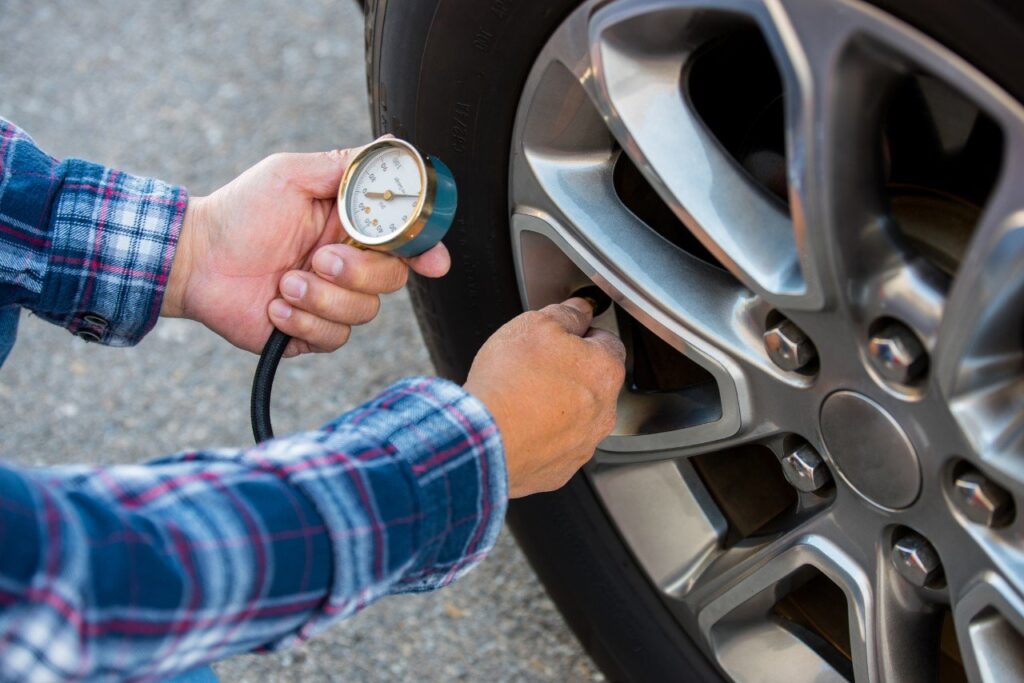Summer heat can have a significant impact on your vehicle’s tire pressure, affecting both safety and performance. As temperatures rise, the air inside your tires expands, leading to overinflation, while sudden temperature drops can cause underinflation. Both scenarios can result in poor fuel efficiency, uneven tire wear, and even blowouts. Checking your tire pressure in summer Regularly checking your tire pressure during the summer months ensures a smooth and safe driving experience, reducing the risk of accidents and costly repairs.
Key Points
- Heat Makes Tire Pressure Rise
- Safety Risks of Overinflated or Underinflated Tires
- Better Fuel Efficiency with Proper Pressure
- Longer Tire Lifespan
- Handling and Comfort on Hot Roads
Heat Makes Tire Pressure Rise

Summer heat isn’t just tough on you it’s tough on your tires too. When the temperature climbs, the air inside your tires expands. For every 10°F increase in temperature, tire pressure can go up by about 1 PSI (pounds per square inch). So, if you’re cruising through a 90°F day after setting your tires in cooler spring weather, they could be overinflated before you know it.
Overinflation changes how your tire sits on the road. The center bulges out, wearing it down faster and making it more prone to blowouts. Checking your tire pressure regularly say, once a month or before a long drive keeps you in the safe zone. Grab a tire gauge (they’re cheap and easy to use) and compare it to the recommended PSI on your car’s door jamb sticker.
Key Reasons to Check Your Tire Pressure in Summer
Safety Risks of Overinflated or Underinflated Tires

Let’s get real tires are your car’s only connection to the road. You’re rolling the dice if they’re not at the right pressure. As I mentioned, overinflated tires wear unevenly and can pop under stress, especially on sizzling asphalt. Underinflated tires, on the other hand, flex too much, overheat, and increase your stopping distance.
I once knew a guy who skipped this step before a beach trip his tire blew out halfway there, stranding him in the heat with a car full of melting ice cream.
Better Fuel Efficiency with Proper Pressure

When your tires are at the right pressure, they roll smoothly with less resistance. Underinflated tires drag like a sulky teenager, forcing your engine to work harder and guzzle more Fuel. In summer, when fuel prices often spike with travel season, Checking your tire pressure in summer this can add up fast. Studies show properly inflated tires can boost fuel efficiency by up to 3%.
You’re driving to a summer festival, and that extra efficiency means you’ve got cash left over for a cold lemonade instead of pouring it all into your tank. Check your pressure, and let your tires help you stretch that Fuel money a little further.
Longer Tire Lifespan

Replacing them sooner than necessary is a hit to the wallet no one wants. Summer heat already puts extra wear on your rubber, but incorrect pressure makes it worse. Overinflated tires wear out the center tread, while underinflated ones chew up the edges. Either way, you’re shaving months or even years off their life.
By keeping the pressure just right, you’re spreading the wear evenly, like butter on toast. I’ve seen friends double their tire lifespan just by staying on top of this. Plus, in summer, when potholes and debris from construction pop up, Checking your tire pressure in summer well-maintained tires are tougher and less likely to give out.
Handling and Comfort on Hot Roads

Ever notice your car feeling a bit off on a hot day, maybe it’s sluggish around turns or bouncier than usual. Tire pressure plays a huge role in how your vehicle handles. Overinflated tires make your ride stiff and jittery think of it like riding a bike with rock-hard tires. Underinflated ones feel mushy, slowing your response time and making steering a chore.
In summer, when roads shimmer with heat and sudden storms can slick things up, you want peak control. Proper pressure keeps your car steady and your ride smooth, whether you’re dodging traffic or cruising down a back road. It’s like giving your car a cool drink of water it just performs better.
Conclusion
Maintaining proper tire pressure in summer is a simple yet crucial aspect of vehicle safety. Regular checks can prevent unexpected breakdowns, improve fuel efficiency, and extend the life of your tires. Whether you’re heading on a long road trip or commuting daily, taking a few minutes to monitor your tire pressure can make a big difference. Stay safe on the road by keeping your tires properly inflated all summer long.
Frequently Asked Questions (FAQs)
Q1. How often should I check my tire pressure in summer?
Aim for once a month, or before any long trip. Summer heat can shift pressure fast, so staying consistent keeps you safe.
Q2. What’s the best time of day to check tire pressure?
Check it in the morning before you drive, when the tires are cold. Driving heats, them up and gives you a higher reading that’s less accurate.
Q3. Can I just rely on my car’s tire pressure monitoring system (TPMS)?
It’s a great backup, but don’t lean on it completely. TPMS only warns you when the pressure’s way off manual checks catch smaller changes early.
Q4. What if I don’t have a tire gauge?
Most fuel stations have air pumps with built-in gauges. Swing by one it’s usually free or just a quarter.
Q5. Does summer heat damage tires that much?
Yes, Heat speeds up wear and tear, especially if the pressure’s off. Think of it like running a marathon in flip-flops things break down faster.
Q6. How do I know the right pressure for my tires?
Look at the sticker inside your driver’s side door or in your car’s manual. It’s tailored to your vehicle, not just the tire.








